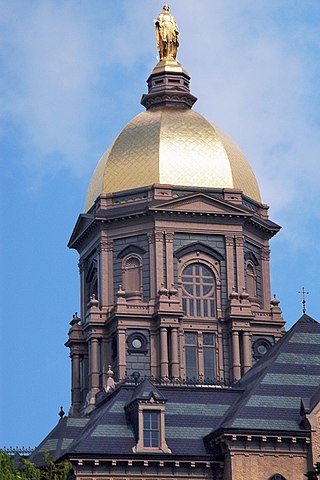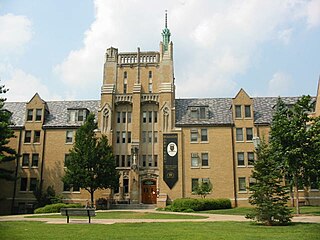
The University of Notre Dame du Lac, known simply as Notre Dame, is a private Catholic research university in Notre Dame, Indiana. French priest Edward Sorin founded the school in 1842. The main campus of 1,261 acres has a suburban setting and contains landmarks such as the Golden Dome, the Word of Life mural, Notre Dame Stadium, and the Basilica. Originally for men, the university started accepting undergraduate women in 1972.

Notre Dame Stadium is an outdoor football stadium in Notre Dame, Indiana, the home field of the University of Notre Dame Fighting Irish football team.

Keenan Hall is one of the 32 Residence Halls at University of Notre Dame. It is located on North Quad in front of North Dining hall, between Zahm Hall and Stanford Hall. Keenan Hall shares the building and The Chapel of The Holy Cross with adjacent dorm Stanford.

Alumni Hall is one of the 32 Residence Halls on the campus of the University of Notre Dame and one of the 16 male dorms. It is located on South Quad adjacent to "Main Circle", across from the law school building, and it hosts 234 undergraduates.

St. Edward's Hall is one of the 32 Residence Halls on the campus of the University of Notre Dame and one of sixteen male dormitories. Saint Edward's Hall is located directly east of the Main Administration Building and is directly west of Zahm Hall and houses 162 undergraduate students. The dorm community and culture are not as old as Sorin College (1888) as it was established as an undergraduate residence hall 30 years later. However the building itself was built in 1882 to house the minims, Notre Dame's boarding school program. When such program was discontinued in 1929, the building was converted to an undergraduate residence hall, which it has been ever since. Together with other historical structures of the university, it is on the National Register of Historic Places. The coat of arms is the Cross of Saint Edward the Confessor on a green background.

Sorin Hall, nicknamed Sorin College, is the oldest of the 32 residence halls on the campus of the University of Notre Dame and one of the 17 male dorms. It is named after Fr. Edward Sorin, C.S.C., the founder of Notre Dame. Sorin is located directly north of Walsh Hall and is directly south of the Basilica of the Sacred Heart. Sorin houses 143 undergraduate students. Sorin Hall is, along with other buildings on the Main Quad of Notre Dame, on the National Register of Historic Places. Sorin Hall was the first Notre Dame residential hall established as such, although St. Edward's Hall is housed in an older building.

Badin Hall is one of the 32 Residence Halls on the campus of the University of Notre Dame and one of the 14 female dorms. The smallest residence hall on campus, it is located on South Quad, between Howard Hall and the Coleman-Morse center. It was built in 1897 and hosted the Manual Labor School until 1917 before being converted into a men's dorm. During World War II, it was part of the United States Naval Reserve Midshipmen's School, and in 1972 it became one of the first two residence halls at Notre Dame to host women.

The University of Notre Dame School of Architecture was the first Catholic university in America to offer a degree in architecture, beginning in 1898. The School offers undergraduate and post-graduate architecture programs.

Cartier Field was a stadium in Notre Dame, Indiana, first dedicated on May 11, 1900, as an arena for football, baseball, track and field, and bicycling. It hosted the University of Notre Dame Fighting Irish football team from 1900 to 1928 and held nearly 30,000 people at its peak. The stands were torn down after the 1928 season to make room for Notre Dame Stadium, which opened in 1930. Notre Dame played its entire 1929 schedule away from campus, went undefeated (9–0) and won the National Championship. At Coach Knute Rockne's insistence, Cartier Field's grass was transplanted into Notre Dame Stadium.
There are currently 33 undergraduate residence halls at the University of Notre Dame, including 32 active residence halls and Zahm Hall, which serves as a transition dorm when residence halls undergo construction. Several of the halls are historic buildings which are listed on the National Register of Historic Places. Each residence hall is single-sex, with 17 all-male residence halls and 15 all-female residence halls. Notre Dame residence halls feature a mixed residential college and house system, where residence halls are the center of the student life and some academic teaching; most students stay at the same hall for most of their undergraduate studies. Each hall has its own traditions, events, mascot, sports teams, shield, motto, and dorm pride. The university also hosts Old College, an undergraduate residence for students preparing for the priesthood.

Patrick J. Filley was an American college football player, coach, and university administrator.

University of Notre Dame's Main Administration Building houses various administrative offices, including the office of the President. Atop of the building stands the Golden Dome, the most recognizable landmark of the university. Three buildings were built at the site; the first was built in 1843 and replaced with a larger one in 1865, which burned down in 1879, after which the third and current building was erected. The building hosts the administrative offices of the university, as well as classrooms, art collections, and exhibition spaces. The building is listed on the National Register of Historic Places.

The 1986 Notre Dame Fighting Irish football team represented the University of Notre Dame in the 1986 NCAA Division I-A football season. The team was coached by Lou Holtz and played its home games at Notre Dame Stadium in South Bend, Indiana.

The 1992 Notre Dame Fighting Irish football team represented the University of Notre Dame in the 1992 NCAA Division I-A football season. The team was coached by Lou Holtz and played its home games at Notre Dame Stadium in South Bend, Indiana.

Morrissey Hall is one of the 32 Residence Halls on the campus of the University of Notre Dame and one of the 16 male dorms. Built in 1925-1926, its architects were Vincent Fagan and Francis Kervick. Along with other buildings on Notre Dame's campus, it is on the National Register of Historic Places. It is referred to as Morrissey Manor by its residents.
The 1932 Notre Dame Fighting Irish football team was an American football team that represented the University of Notre Dame as an independent during the 1932 college football season. In its second season under head coach Hunk Anderson, the team compiled a 7–2 record and outscored opponents by a total of 255 to 31. Paul Host was the team captain. The team played its home games at Notre Dame Stadium in South Bend, Indiana.
The 1928 Notre Dame Fighting Irish football team represented the University of Notre Dame during the 1928 college football season. Led by eleventh-year head coach Knute Rockne, the independent Irish compiled an uncharacteristic 5–4 record and were outscored 99 to 107. The defeat of Army was the Win one for the Gipper game.

The campus of the University of Notre Dame is located in Notre Dame, Indiana, and spans 1,250 acres comprising around 170 buildings. The campus is consistently ranked and admired as one of the most beautiful university campuses in the United States and around the world, particularly noted for the Golden Dome, the Basilica and its stained glass windows, the quads and the greenery, the Grotto, Touchdown Jesus, its collegiate gothic architecture, and its statues and museums. Notre Dame is a major tourist attraction in northern Indiana; in the 2015–2016 academic year, more than 1.8 million visitors, almost half of whom were from outside of St. Joseph County, visited the campus.

Breen-Phillips hall is one of the 32 Residence Halls on the campus of the University of Notre Dame and one of the 14 female dorms. Breen-Phillips is on North Quad, between Farley Hall, Geddes Hall, and the Hesburgh Library. Established in 1939, it hosts 200 students.

Carroll Hall is one of the 33 Residence Halls on the campus of the University of Notre Dame and one of the 16 male dorms. Carroll is located on the shores of St. Mary's Lake, and is the smallest of the residence halls, housing around 100 undergraduates.

















